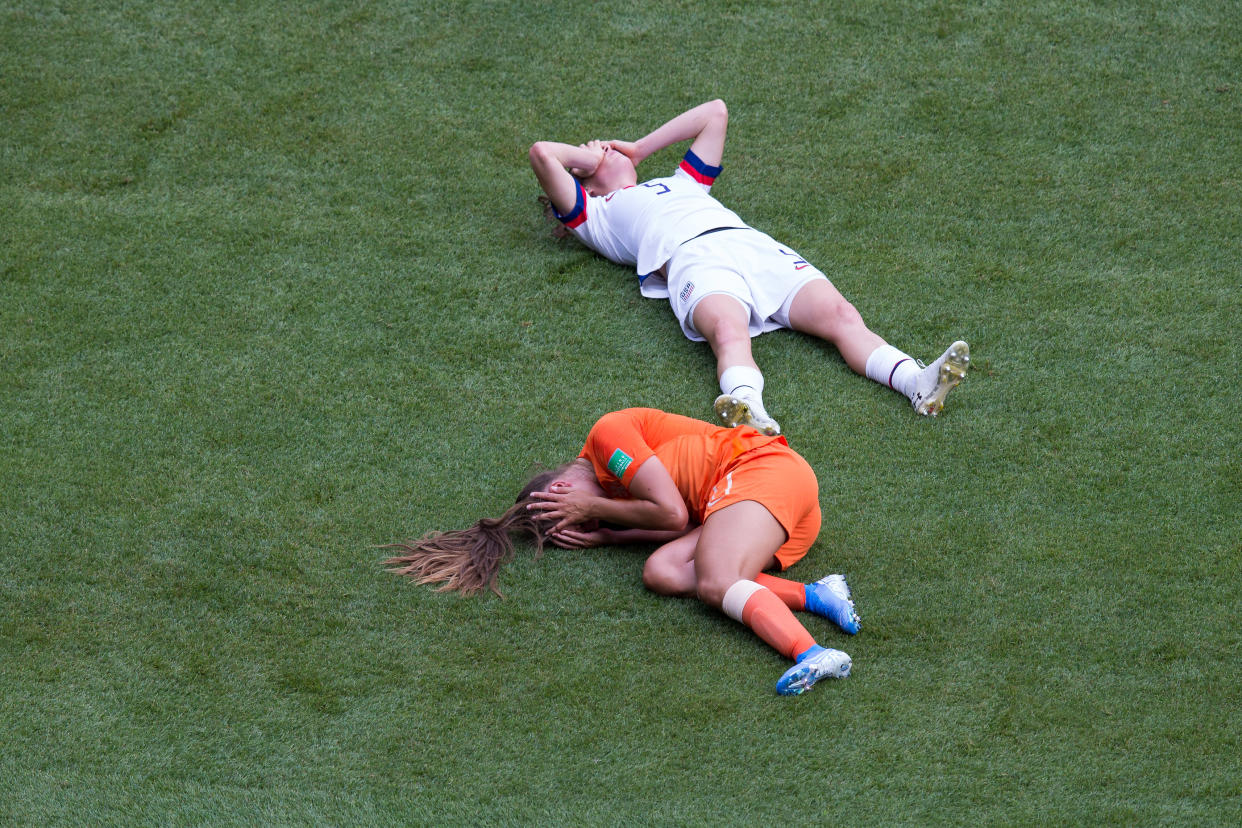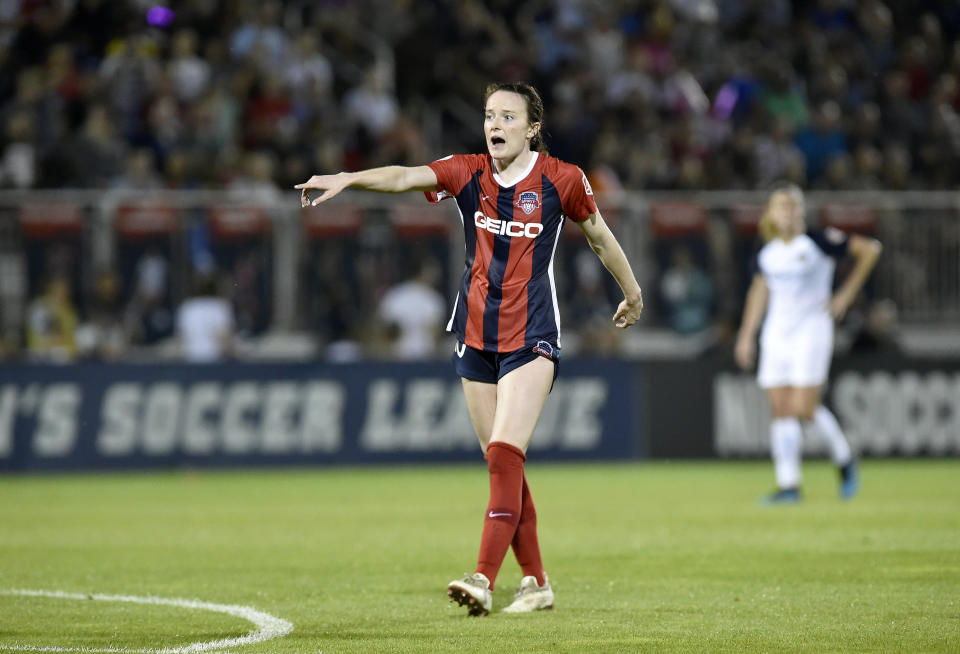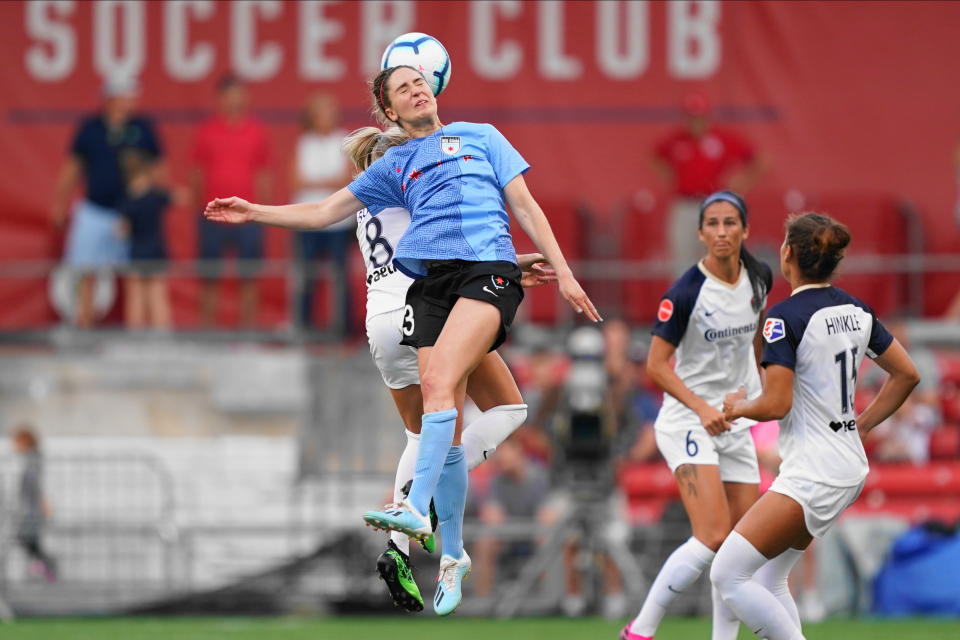How the NWSL and American soccer are trying to fight the sport's concussion problem

Soccer has a concussion problem.
The NFL may get the headlines because of its high-profile cases of the brain disease known as CTE, but head injuries are prevalent in soccer too, and the sport's protocols – for now, at least – continue to go against the advice of medical professionals. Players who are knocked out cold can still return to the field, and players hit in the head aren't fully evaluated for concussions, whether it's a low-tier club game or the World Cup.
But there is a growing sense of urgency from some corners of the sport to change that.
The U.S. Soccer Federation, which founded the NWSL and has managed the league since its inception, considered the possibility of the NWSL piloting a temporary substitution rule for players suspected of suffering a concussion, sources tell Yahoo Sports. The federation discussed informing FIFA, the global governing body of soccer, and its rulemaking arm, IFAB, that the NWSL would be willing to run trials on new rules for head injuries.
Those discussions never made it far enough to reach NWSL owners though, in part because FIFA and IFAB would first need to signal that they are open to considering a substantive change to the laws of the game. Owners contacted by Yahoo Sports said they would've supported the pilot program.
U.S. Soccer and the American soccer leagues – MLS, the NWSL and USL – co-signed a letter earlier this year urging FIFA and IFAB to update the current concussion protocol, which determines how in-game head injuries are handled. The letter proposed extending the amount of time that a referee is able to stop play while a player is evaluated on the field, as well as looking at rule changes to allow for an additional substitution if a player is suspected of having a concussion.
[ Follow Yahoo Soccer on Twitter and Facebook ]
FIFA's nine-member medical committee, which includes U.S. Soccer chief doctor George Chiampas, asked last month that IFAB add the topic to the agenda for its annual meeting where new rules are approved. The medical committee recommended that the current allotment of three minutes to evaluate suspected concussions be extended to a mandatory 10 minutes.
“At U.S. Soccer, we’ve been really focused on what we can do to make sure we are a leader in the area of concussion safety, which is why we launched the Recognize to Recover program a few years ago,” Chiampas said in a statement, referring to the federation's education campaign around head injuries. “We’re also in constant conversations with the FIFA medical committee to determine how else we can make consistent progress in this area.”
There are many options FIFA could consider.
Some advocates want a temporary substitute, which would give doctors and players enough time to evaluate the injury before deciding to use a permanent substitution. Others advocate for a head injury sub where it wouldn't cost the team a substitution to take off a player who shows signs of a concussion. There are other creative possibilities, like having the opposing team take a player off so each team is down a player during the concussion test to keep the competition level.
“I'm fine trying anything but it's got to be the correct rule,” North Carolina Courage coach Paul Reilly told Yahoo Sports. “I don’t know what the correct rule is though – I've not the foggiest idea what you'd do. It's the same with VAR, they tried it in the Women's World Cup and it didn't work so well, but it will eventually be something we have to have in our league.”
Whatever the changes look like, they are clearly needed – especially in the NWSL. Some studies show concussions have a greater impact on women, and female soccer players suffer concussions at a higher rate than their male counterparts.
Just this season alone, the NWSL has had its share of concussion scares and missteps, too.

Washington Spirit playmaker Rose Lavelle took a hit to the head in August so hard that the sound of impact reverberated around Providence Park, and she looked woozy as she gingerly walked off the field. But within in five minutes, she could be seen arguing with medical staff that she was fine, emphatically standing on one foot and threw her arms out as if to say, “See? I'm fine.”
Within about seven minutes of her head injury, she was cleared to rejoin the game in progress. But once the game ended, there were hints she wasn't fine. A communications staffer said Lavelle wasn't feeling up to talking to the press in the mixed zone. Her teammate, Andi Sullivan, was asked about how important it was to have Lavelle back on the field, and she expressed concern instead.
“Rose is extremely important, but health and safety is the most important thing,” Sullivan said in the postgame mixed zone. “I’m glad they cleared her to play, and I hope that was the right decision.”
It wasn't the right decision. In the days after that match, Lavelle failed to clear concussion protocols and, as she joined the U.S. women's national team on an international break, she did not appear in either victory tour match.
Players who continue to play after sustaining a concussion risk secondary impact syndrome, which is potentially fatal. But Lavelle is hardly the first player, nor will she be the last, who has argued to be allowed back in the pitch after a hit to the head.
The problem isn't the players wanting to keep playing – the problem is that players shouldn't have any say. Unfortunately, the current concussion protocol around the world is too easily swayed by sporting concerns over medical ones.
After all, one of the most memorable and shocking moments of the 2014 men's World Cup was when Uruguay's Alvaro Pereira got knocked out cold, lying on the ground seemingly unconscious before he eventually stumbled to the sideline – then arguing with the doctor who gave the substitution signal to the officials. Pereira yanked the doctor's arms down and waved his finger in the doctor's face, “No!” He went on to play the entire match.
Morgan Brian, a midfielder for the U.S. women's national team and the Chicago Red Stars, says the decision should never be left to the players.
“You get hit in the head, and you have adrenaline, and of course we want to play and get back on the field, so your judgement is clouded,” she told Yahoo Sports. “I've had concussions where I get hit in the head and I feel fine, but then I go home and that night it's like, ‘I am not fine.’
“Medical staff should say yes or no – there should be no gray area,” she added. “The player will hate the medical person for saying but I'm sure the next day they will understand. I do think a lot of decisions at this moment fall into the players' hands.”
The prevailing concern about changing the rules is that it would change the flow of the game – and it could even lead to cheating as teams seek to exploit an extra substitute. But advocates say head injuries and concussions, which can be life-threatening, are serious enough to warrant the changes.

Taylor Twellman, whose MLS career ended due to concussions and who still experiences residual headaches and dizziness to this day, has been an outspoken advocate for changes. A severe penalty for gaming the system – whether it's player suspensions, forfeiture of points, or fines – should mitigate those concerns.
“You can change the game for the better and still not take away from the core of the sport,” he told Yahoo Sports. “If you did add a head injury substitution and you made sure you crossed your Ts and dotted your Is so no one can cheat, why wouldn't you do it? No one is going to cheat the rule if you put a strong penalty against cheating.
“While concussion awareness and education is further along in the United States than any other country, I'm surprised more hasn't been done,” he added. “I wouldn’t be shocked if it's ultimately U.S. Soccer who has to push FIFA.”
The Video Assistant Referee or VAR, offers clear proof that FIFA and IFAB are willing to change the game, and the rollout of VAR offers a blueprint for how changes could be added around concussions. MLS offered to be the guinea pig and quietly ran VAR trials for years before FIFA and IFAB approved the technology to be used in official competitions around the world.
If MLS and the NWSL are willing to serve as a testing ground on new concussion rules, IFAB says they need permission first.
“Any such experiment would need IFAB approval as these must be in line with certain protocols which the IFAB defines,” the organization said in a statement to Yahoo Sports. “The IFAB would also be closely monitoring such experiments in order to have first-hand insight into the processes and eventually results.”
IFAB ignored repeated questions from Yahoo Sports about whether the organization would be willing to approve such requests. But it appears changes around concussions will likely be on the agenda for discussion at IFAB's upcoming meeting in December. The next time rule changes can be approved will be in March at the IFAB annual general meeting.
For now, it's unclear how far FIFA and IFAB are willing to go to address the problem of head injuries in soccer, but advocates are optimistic that the topic is being discussed more. Players, coaches and owners in the NWSL that Yahoo Sports spoke to said they'd support it being tested in their league.
“It's something we have to try, and trial and error is the only way,” Brian said. “It's like with VAR and penalty kicks on the goal line – we tried that in a World Cup and it didn’t work so the rule got changed. It'd be nice to try it in games that matter less than a World Cup.”
Caitlin Murray is a contributor to Yahoo Sports and her book about the U.S. women’s national team, The National Team: The Inside Story of the Women Who Changed Soccer, is out now. Follow her on Twitter @caitlinmurr.
More from Yahoo Sports:
